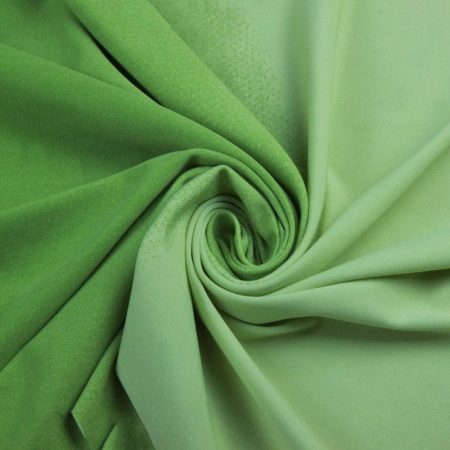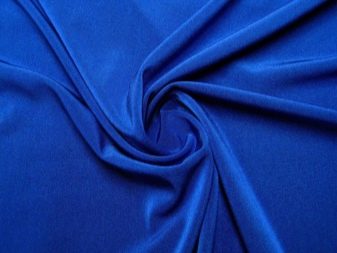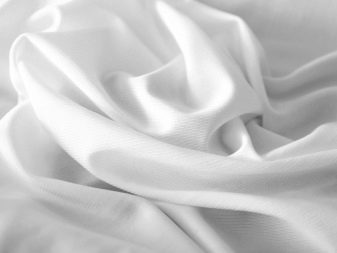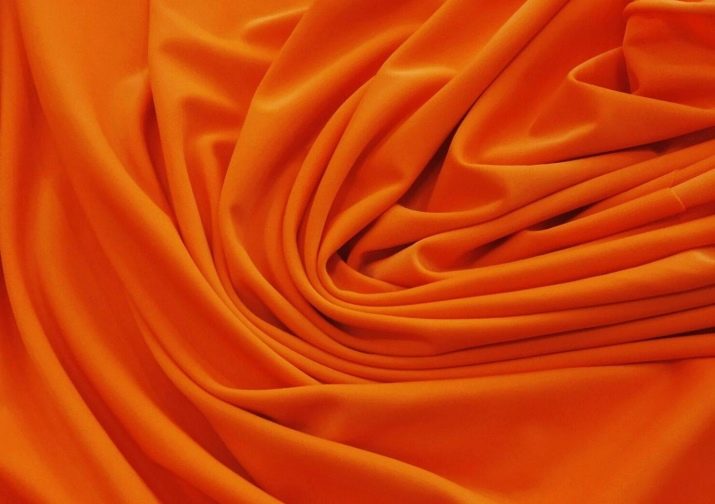All about the fabric "oil"

Knitwear "oil" is one of the most popular fabrics. It is an optimal tandem of budgetary, but at the same time comfortable, comfortable and beautiful clothes. Women love this material because it favorably emphasizes all the advantages of the figure and skillfully masks its flaws. Let's take a closer look at the description of this unusual matter.


What it is?
The composition of knitted fabric "oil" includes three types of fibers - viscose, polyester, better known as polyester, and lycra. The quality and thickness of different types of yarn may vary depending on the type of fabric, on average, the structure includes up to 75% viscose and up to 30% polyester.
Lycra is introduced as a special component. It is an ultra-fine thread that can stretch up to 800%. It is included in the canvas solely to increase elasticity, therefore its share is negligible. Besides Lycra is usually used not in isolation, but as part of a thickened yarn in which the thread is braided with polyester fibers.

The advantage of this structure is that the yarns appear textured and this improves the overall texture of the web.
For the first time knitwear "oil" was invented in the UAE. From there he came to the countries of the Old World and soon became popular all over the world.
It is no secret that the inhabitants of the East have always been famous for the fact that they especially appreciated expensive canvases and chic clothes. The “oil” fabric has become a real boon for them, since spectacular and very stylish things come out of this fabric.


Basic properties
Knitwear "oil" has the following characteristics:
- increased density of weaving with a relatively low thickness of the fabric;
- high elongation combined with softness;
- Lycra fibers provide good elasticity and the ability to quickly restore their original shape;
- viscose fibers give the oil a silky shimmer and, in addition, increase its heat transfer and hygienic characteristics;
- polyester inclusions provide crease resistance, durability and wear resistance of the material;
- matter is produced in a wide variety of saturated shades - monochromatic and multi-colored;
- the structure of the fibers allows you to create decorative elements on the surface of the fabric, including the printing of ornaments;
- the canvas has a long service life, it is resistant to wear and tear and serves its owners for many years;
- jersey does not require special storage conditions, while it dries up in just a few minutes;
- clothes made of “oil” knitted fabric retains the brightness of colors and does not fade even with prolonged exposure to ultraviolet rays;
- in the process of wearing, the fabric does not stretch, deform or become covered with pellets.


However, the "oil" is not without its drawbacks:
- low thermal insulation;
- low hygroscopicity;
- the risk of allergic reactions, including skin irritation;
- the canvas builds up static electricity.

And, finally, knitwear "oil" is prone to the formation of puffs - this significantly impairs the appearance of the product.
Species overview
There are several types of knitwear with the unusual name "oil".
- Winter (cold) "oil" - this fabric stretches in all directions. It feels like velvet to the touch, and its sheen is similar to silk. The material is opaque, it resists washing and is neutral to the effects of sunlight.

- Viscose "oil" - very soft velvety fabric. Due to the presence of polyester threads, it can create spectacular folds flowing over the body. The fabric is distinguished by a muted matte surface.

- "Crystal" - the linen includes viscose, as well as polyester with an admixture of lycra. It got its name for a rich shimmering shine with spectacular overflows. As a rule, it is performed in bright colors.


- Brushed jersey - delicate and very soft material, used for the manufacture of warm products. On the back there is a fleece of viscose fluff.

- Stuffed "oil" - multi-colored matter. It is distinguished by spraying, decorated with printed patterns, drawings or stylish prints.

- Classic "oil" - a standard canvas with a barely noticeable matte sheen and a dense dense structure. In demand for the manufacture of combinations and nightdresses.

- "Mikromoil" - airy, very light, almost weightless canvas. It is distinguished by increased elasticity, its unusual structure is formed due to the interweaving of threads of various textures.

Selection Tips
When choosing knitwear "oil", the following factors should be taken into account.
- Despite all its strength, such matter is prone to the appearance of clues. If you hit your clothes with a pointed object, a visible mark will appear on it.
- It is not worth buying knitwear "oil" for children and people prone to allergic and asthmatic diseases. It is 100% man-made fabric. Despite the fact that viscose is of natural origin, during the production process it is treated with powerful chemical reagents. In this regard, in terms of its characteristics, it is fully equated to synthetic ones.
- Even varieties of linen with maximum air permeability exhibit weak thermoregulation. Therefore, they will not cool in the heat and warm in the cool.

For the sake of fairness, it should be noted that for the most part these shortcomings are typical of cheap knitwear made in China and Korea. Expensive canvases made in Turkey and the United Arab Emirates have much higher performance characteristics, therefore they retain their aesthetic appearance for a long time. Canvases from Italy and Russia also have good quality.

Applications
The main purpose of such a cloth is to make tight skirts, as well as tops, dresses and blouses. However, thanks to the beautiful matte sheen, things made of this material do not look defiant, therefore they can be used to compose both ceremonial and everyday wardrobe.
Knitwear oil is in demand for sewing home, sports and festive clothing.

From it you can sew models for both thin and overweight women. Some types of such matter are relevant for creating stage and concert outfits.
They are used to make leotards for the performance of gymnasts, as well as costumes for participants in figure skating and dancing competitions. "Oil" adheres to the skin, does not hinder movements and, moreover, shines, which increases the aesthetic effect of the performance.


Features of working with material
According to the reviews of the dressmakers, it is not difficult to work with “butter” knitwear. However, cutting and sewing such a canvas has its own characteristics.
So, when sewing, you need to proceed from the following rules.
- For sewing, it is best to design a knitted seam or a loose zigzag.
- It is advisable to use needles marked with superstretch or jersey. They have the ability to delicately push the fibers of the fabric apart without piercing them. This minimizes the risk of arrows and holes.
- The places of the cuts do not crumble, so there is no need to process them with an overlock.
- To prevent the upper part of the product from stretching during sewing, the seam cutting line must be sealed with a special silicone tape. It will hold the bottom of the dress, not allowing the bodice to deform.
- The hem is best done with a roller stitch or sewn with a double needle.
- The edging of the neckline is made of the same fabric. For this, a double plank or edging is sewn.

There are also recommendations for cutting the material.
- In order for clothes made of “oil” fabric to fit the figure perfectly and at the same time not cause any discomfort, the fabric should be cut without allowances for seams - this will allow you to achieve the most tight-fitting silhouette.
- Before cutting, be sure to test for arrows. If they appear, you should refuse to perform additional cuts and undercuts.
- Matter tends to stretch noticeably, therefore, when sewing, it is necessary to make two or three fittings. This will reduce the likelihood of errors.

Care rules
"Oil" is practical and easy to use. Fabric care is not particularly difficult. Nevertheless some rules should be adhered to - only in this case the thing will retain its original appearance for a long time.
Washing
Knitwear "oil" is quite durable. However, it is synthetic in nature, therefore it is considered vulnerable to the action of certain chemicals and the high temperatures that matter encounters during the washing process.
That is why it is necessary to wash clothes made of such fabrics exclusively in a delicate mode using gentle washing powders without any aggressive components.

Drying and ironing
It is advisable to dry the oil cloth in natural conditions. It is not necessary to do this in open sunlight, especially since you do not need to hang wet products on the battery. If ironing is necessary, do not heat the iron to a temperature above 110 degrees - the ironing mode should be the same as when processing silk. During smoothing, the product itself should be moistened from time to time with water from a spray bottle. It is best to iron it immediately after washing, undried.









